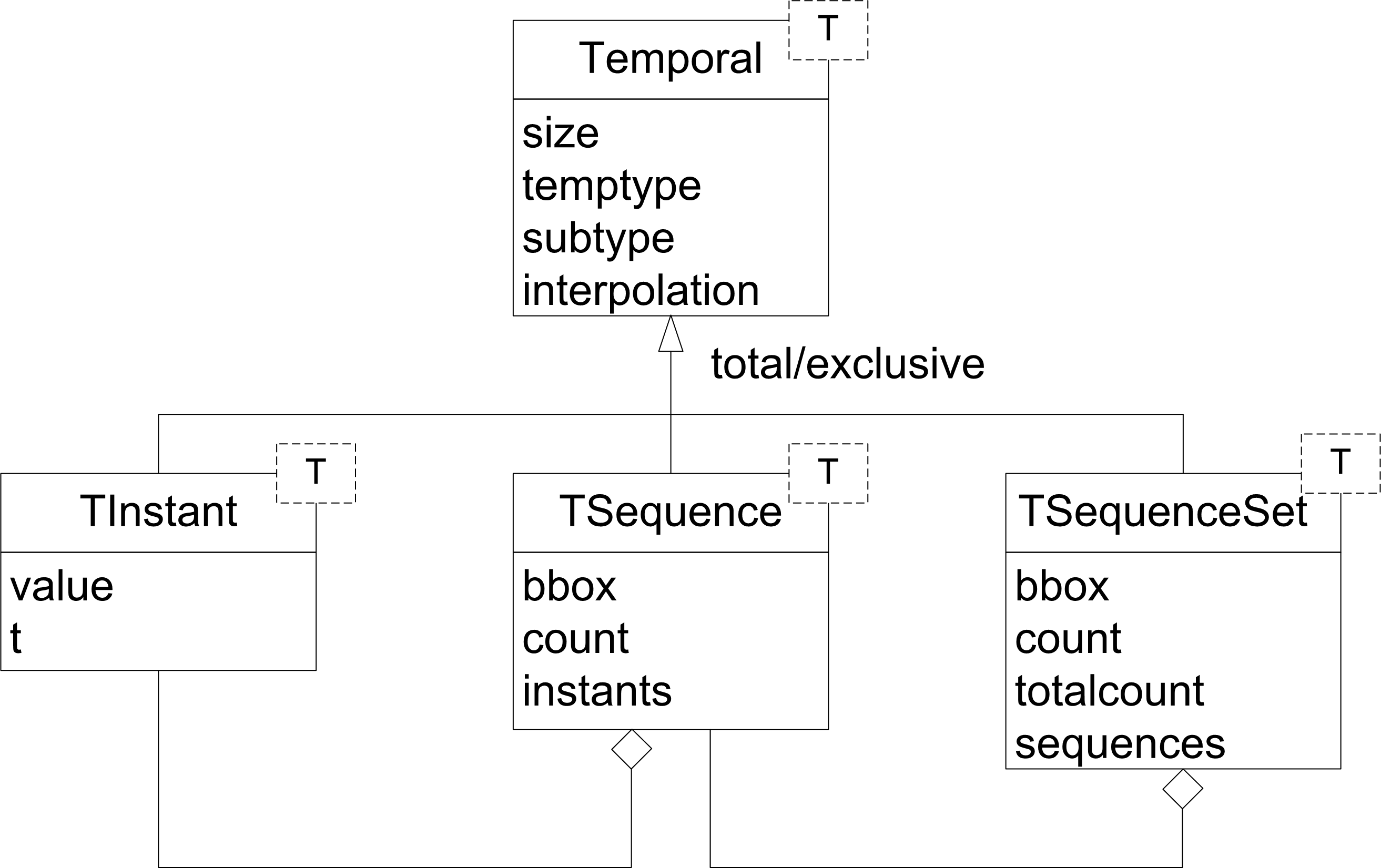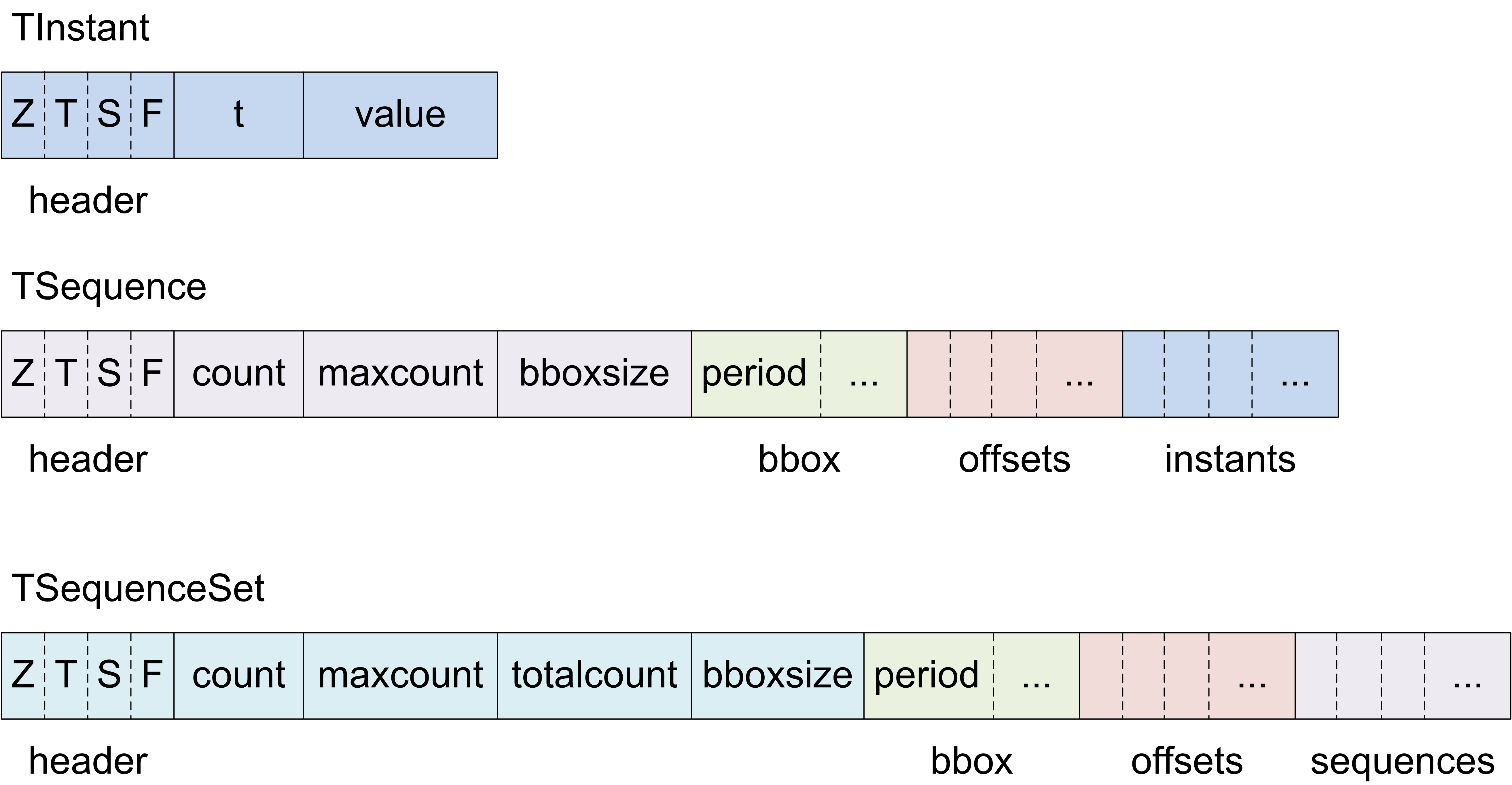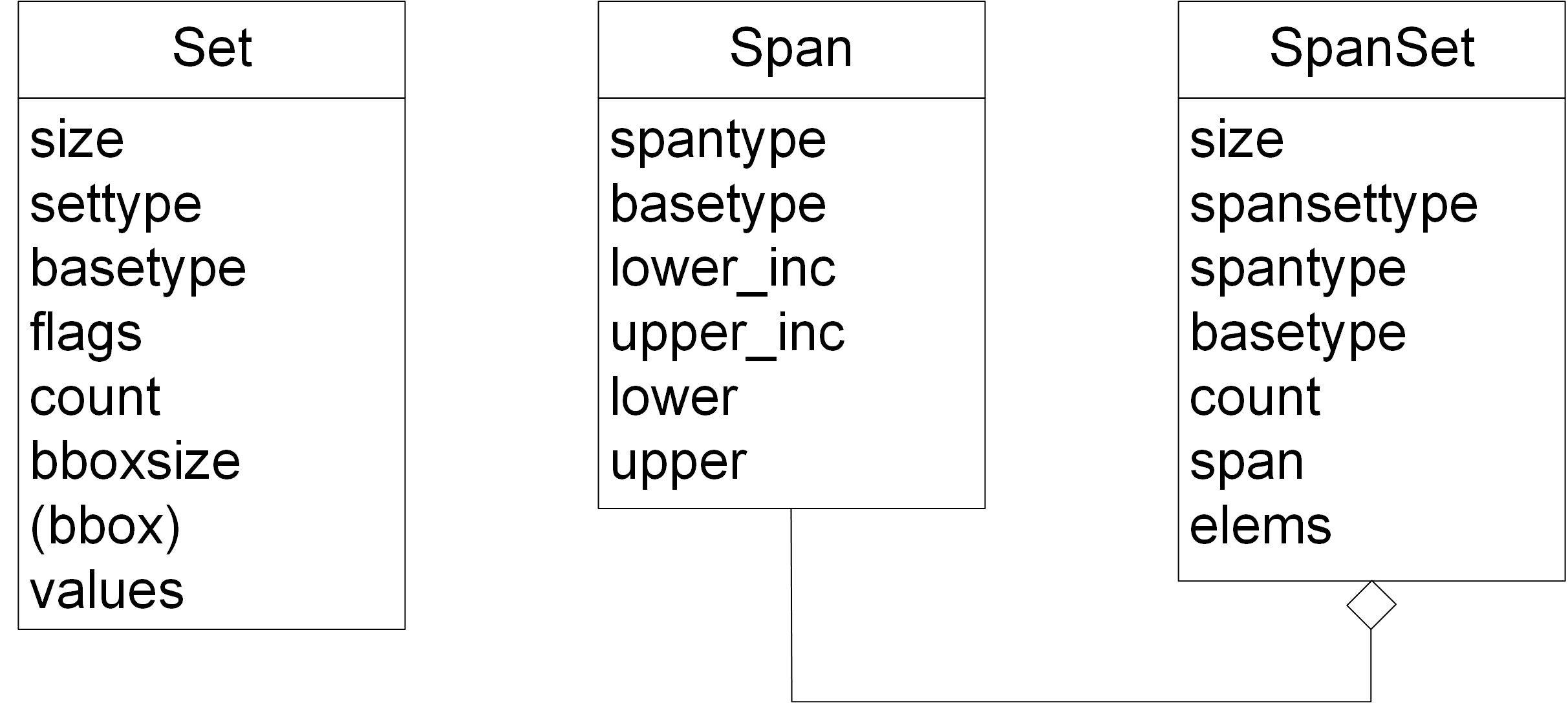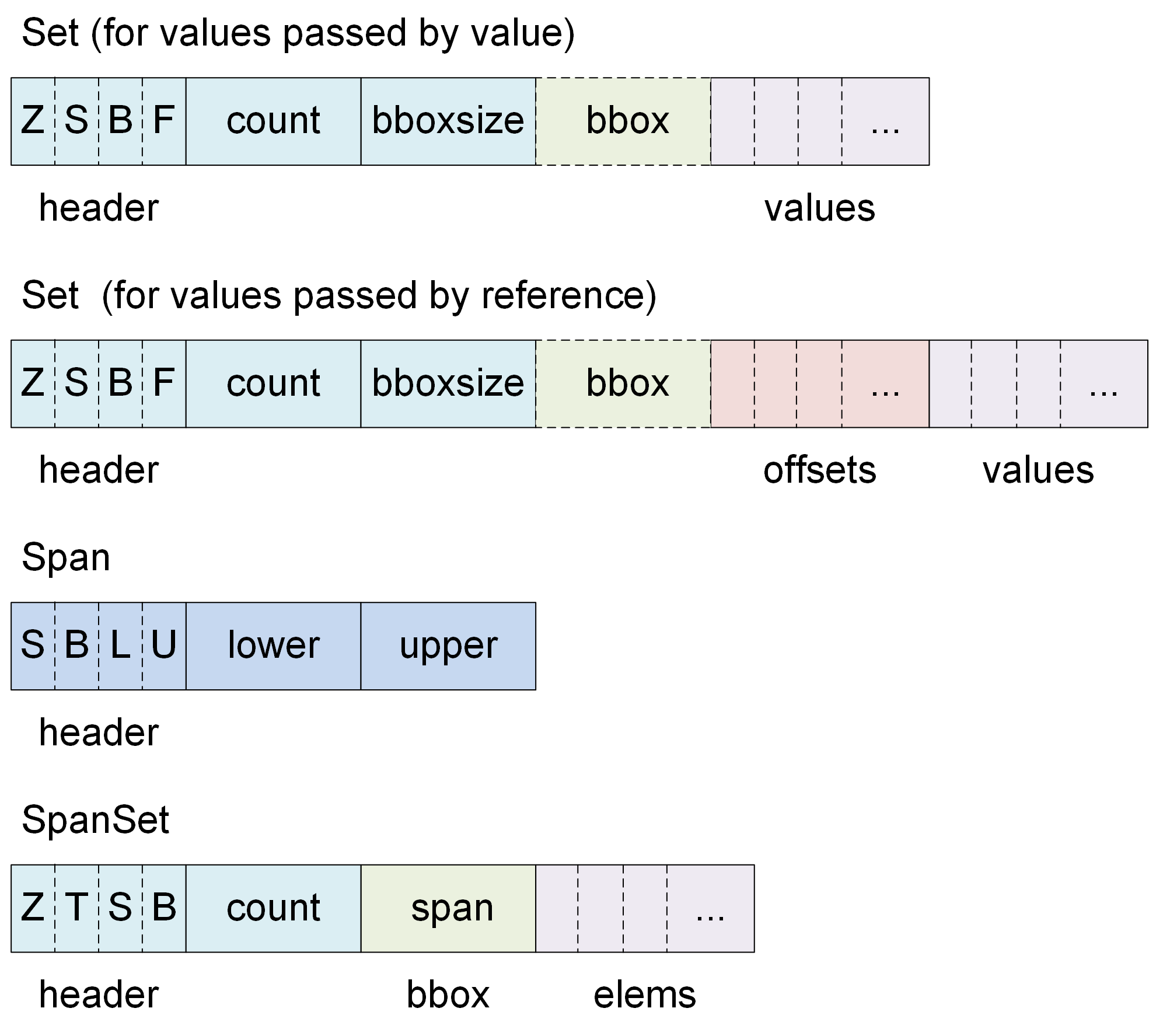Data Structures
Although MEOS is written in C, it aims at using well-proven object-oriented concepts for its development. The data model for the temporal types is implemented using the following conceptual type hierarchy.

The supertype Temporal is a template type since it is used for all temporal types, such as temporal integers or temporal points. Temporal is also an abstract type, since it cannot be instantiated, only its subtypes can. Temporal types are variable-length types: the size of an instance in bytes is kept in the size attribute. The specific type of an instance (such as tintor tfloat) is defined in the temptype attribute. The specific subtype of an instance (such as TInstantor TSequence) is specified in the subtype attribute. Finally, the interpolation attribute keeps the interpolation used, which can be discrete, linear, or stepwise.
The type TInstant is used for representing a single observation composed of a value and a timestamp t. Timestamps in MEOS keep associated time zone information and are stored using PostgreSQL format, that is, in microseconds from January 1st, 2000 at 00:00:00 in Coordinated Universal Time (UTC), which is equal to Greenwich Mean Time (GMT). Notice that other systems, for example PostGIS trajectories, use Unix time in which time is represented in milliseconds from January 1st, 1970 at 00:00:00 UTC. In temporal instant values, the flags attribute specifies whether the value is passed by value or by reference, or whether the base type is discrete or continuous.
The type TSequence is used for representing a set of observations where an interpolation function is used for determining the value between observations. MEOS provides three interpolation functions: discrete, where the value is unknown between observations, stepwise where the value remains constant between consecutive observations, and linear, where the value evolves linearly between consecutive observations. For temporal sequence values, the flags attribute specifies the interpolation function used. The count attribute specifies the number of observations, the bbox attribute specifies the bounding box that encompasses them, and the instants attribute keeps the observations. The bounding box can be of various types depending on the temporal type:
- for
tboolandttextit is aperiodkeeping only the time extent, - for
tintandtfloatit is aTBoxcomposed of aperiodfor the time extent and afloatspanfor the value extent, and - for
tgeompointandtgeogpointit is anSTBoxkeeping aperiodfor the time extent and the minimum and maximum values of the 2D/3D coordinates for the spatial extent.
The type TSequenceSet is used for representing a set of sequences having the same interpolation function that may have temporal gaps where the value is not known. This situation typically arrives in real-world applications due to signal loss. The count attribute specifies the number of such sequences, while the totalcount attribute specifies the number of observations across all sequences. Finally, the bbox attribute specifies the bounding box that encompasses all observations and the sequences attribute keeps the composing sequences.
The following figure shows the C structures implementing the above conceptual type hierarchy for temporal types.

The structures for all temporal types start with a header, which contains information in the Temporal supertype above shared for all subtypes. It is composed of the size (Z), temptype (T), subtype (S), and flags (F). The flags encodes metadata information such as whether the base values are passed by value or by reference, whether the base values are discrete (e.g., int) or continuous (e.g., float), the interpolation function used, whether the spatial values have a Z dimension, etc.
The TInstant structure stores after the header the timestamp t and the base value.
The TSequence structure stores after the header the attributes count and maxcount, which state, respectively, the current and maximum number of composing values of type TInstant, bboxsize that stores the size of the bounding box, and bbox that stores the bounding box. As indicated in the figure, all bounding boxes start with a period for the time extent, and contain other attributes for temporal numbers (TBox) and temporal points (STBox). The structure contains an array of òffsets, storing the offset of the location of each composing instant with respect to the start of the structure. Therefore, the address of each composing instant can be easily obtained by adding its òffset to the address of the structure. The òffsets array also acts as a temporal index, since the instants are stored in ascending order of timestamp. This enables a binary search of the array, for example, when looking for the value at a given timestamp. This temporal index, combined with the bounding box that is used to quickly filter out values that do not satisfy a predicate, enables an efficient implementation of the temporal operations. Then, the structure stores the composing instants.
Finally, the TSequenceSet structure has similar structure as the TSequence structure, where count and maxcount state the current and maximum number of composing values of type TSequence, totalcount states the total number of instants accross all composing sequences, followed by the size of the bounding box bboxsize, the bounding box bbox, the offsets array, and the composing sequences.
Both the TSequence and TSequenceSet structures are expandable, that is, at the creation time they can allocate space available for storing additional observations later, as stated by the count and maxcount attributes. Furthermore, both structures automatically expand upon update operations when there is no more available space, where by default the size is doubled at each expansion. These features are essential for streaming applications. On the other hand, for historical (that is, batch) processing, the operations create structures without any additional space by simply calling the constructors with the same value for count and maxcount.
MEOS uses set, span, and span set types for representing finite subsets of values from the base and time types. These types are template types, since they are used for constructing multiple types.

The following figure shows the C structures for these types.

The Set structure comes in two variants, depending on whether the values in the set are passed by value or by reference, depicted, respectively, in the topmost and the second structure. The header contains the size (Z), settype (B), basetype (B), and flags (F). Here, the flags encodes metadata information such as whether the values in the set are passed by value or by reference and whether the values in the set are stored in ascending order or not. The bboxsize attribute keeps the size of the bounding box and bbox stores the bounding box. As suggested by the dashed box, the bounding box may not be present, which is the case for alphanumeric values. For spatial values, the bounding box is a spatiotemporal box (STBox) keeping the minimum and maximum values of the 2D/3D coordinates for the spatial extent.
When the values in the set are passed by value, they are stored immediately after the bounding box. Otherwise, the structure contains an array of òffsets, storing the offset of the location of each value with respect to the start of the structure. Therefore, the address of each value can be easily obtained by adding its òffset to the address of the structure. Notice that the òffsets array is only necessary when the values of the set are of variable length, as is the case for the type textset, which contains text values. The òffsets array also act as an index when the set is ordered, since a binary search of the array is performed when looking for a given value. This index, combined with the bounding box that is used to quickly filter out values that do not satisfy a predicate, enables an efficient implementation of the set operations.
The Span structure starts with a header, composed of the spantype (S), basetype (B), lower_inc (L), and upper_inc (U), where the two latter elements state, respectively, whether the lower and upper bounds are inclusive or not.
Then, the structure stores the values of the lower and upper bounds.
Finally, the SpanSet structure starts with a header, composed of the size (Z), spansettype (T), spantype (S), and basetype (B). It is followed by the count attribute, which states the number of composing values of type Span, and the bounding span. The composing span values are kept in the elems array. Since the spans are stored in ascending order, this enables a binary search of the array when, for example, looking whether a given value is contained in the span set. Combined with the bounding box that is used to quickly filter out values that do not satisfy a predicate, this enables an efficient implementation of span set operations.
MEOS uses bounding boxes for efficient manipulation of temporal types. For example, when determining whether a temporal point (e.g., a moving vehicle) overlaps a geometry (e.g., a county), a bounding box test is applied to quickly filter out the temporal points whose bounding box does not overlap the bounding box of the geometry. Then, the computation continues for the values satisfying the bounding box test.
MEOS has three types of bounding boxes depicted next.

The Span type, already described above, is used for temporal types such as tbool and ttext and in this case the bounding box only represents the temporal extent of the value.
The TBox type is used for temporal numbers such as tint and tfloat, where the span attribute represents the value extent and the period attribute represents the temporal extent of the value.
Finally, the STBox type is used for temporal points such as tgeompoint and tgeogpointt, where the period attribute represents the temporal extent of the value, the attributes such as xmin and xmax represent the 2D or 3D spatial extent of the values, the attribute srid identifies the coordinate system, and the flags attribute keeps information such as whether the coordinate system is Cartesian or geodetic.